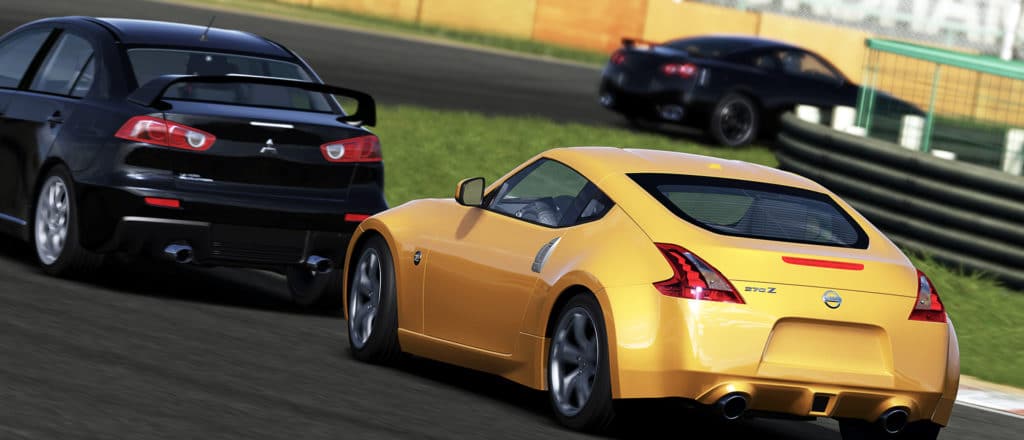It’s Easy To Be Brave When You’re Digital: A Primer Regarding Our Future Video Game Reviews
A little while back, we thought it would be a smashing idea if I started reviewing driving and other car games for Automoblog. It seemed like a natural fit. Automoblog’s founder Chris Burdick and I are both really into video games. And the current crop of games today are technically impressive and a complete hoot to play.
Before we dive into the ups and downs of this game or that, why this wheel and pedal controller is good, and so forth, we all agreed that I should explain myself a little. You know, let everyone know where I’m coming from so the readers can adjust for any biases.
I’ve always enjoyed games. Ever since I was a little kid, playing games was both enjoyable and, for me at least, a safe and controlled environment where a person could be as risky or foolhardy, or as ruthless or conniving, as they wanted to be.

Paid To Play
I have worked off and on in “the gaming industry” since the early 90s, helping to design board games, learning experiences, card-driven random experience blah-blah-blahs and, ultimately, computer games. Indeed, I worked on the Xbox-based driving game Forza Motorsport 4. I was hired as a content expert and sometimes a test-driver. I got the gig because, mainly, I knew a lot about cars and racing but also because I knew a bunch about game design and simulation.
Forza Motorsport is a good game, and it is what I would call a “close” simulation. As good as a modern game like Forza and Assetto Corsa and iRacing (and so on) are, they are not full-on simulations. They are close, but they are not a “real” simulator.
In The Big Leagues
I say this because, peripherally, I have worked with very high-end simulators in the past. I used to work in the aerospace industry. I had the opportunity to be in and around simulators for all sorts of fun stuff. ICBM launch simulators and attack helicopters and satellite maneuvering controls and, at the top of the heap, full motion-controlled, custom-built moving base flight simulators.
The level of fidelity at this stage of the game is beyond the designers of Forza and Gran Turismo’s wildest dreams. I was once taxing a Boeing 757 to a runway for take-off, and I noticed the tar seams on the ramp were mapped into the simulation. We’re rolling along, and, seemingly right under us – under the cockpit, and therefore, under the nose wheel – there was a dampened “wump” noise accompanied by a slight heave upwards by about two inches. A moment later – as the main gear passed over the same tar seam – there was a quieter and more distant “wump” and a smaller, more distant heave.
“You guys mapped the cracks in the runway?” I boggled.
“Yup, to the letter. Every airport that’s in the FAA’s database. Down to the types of gravel in the overruns,” said the flight engineer proudly over my left shoulder (I was in the co-pilot’s chair).
So that is my benchmark. I know how good a simulator can get if you have trainloads of money. Which is why stuff like Xboxes and PlayStations and PCs are a minor miracle. For the cost of a 60,000-mile service on your car (timing belt, all fluids etc.) you can get a pretty darn good “sim” rig all set up and ready to go.
At Home Versus The Track
Personally, outside of my work for Turn 10, I put in more than a working year playing Forza 4. It’s not that it’s perfect. It’s not that it’s better or even as good as driving a real car on a real road, but it is fun, and – and I think this is crucial – it is monumentally safer. When I’m racing in a sim, I’m Tazio Nuvolari on his best day. I have the combined testicular weight of Mario, A.J., and Ari. I will try for that gap, and I bet I make it and if I don’t, c’est la vie! Why? Because there’s a reset button.
It’s easy to be brave when you’re digital. In the real racing world, mistakes have deadly and instantaneous consequences. Real, closed casket levels of consequences. In Forza? Not only can you just start the whole race over, they even have a rewind button.
Driving games are a virtual paradise for gearheads. The downsides of automotive ownership and competition – maintenance, repairs, insurance, grievous bodily harm, and death – are nowhere to be found. Yet, all of the upsides are there: car collections that take literal acres of garage space, tuning and modifying at the touch of a button, instant transportation from one side of the globe to another to race on a real-world track in “real-world conditions” (although some restrictions may apply). Like I said, these types of games have been a virtual paradise for gearheads for a long time now.
With all that background story, here’s where we’ll be going with all this.

How We Will Conduct All Video Game Reviews
First off, I’ll be doing game reviews. We have some in the pipeline already and more on the way. They’ll get as full of a write up as time will allow (to plumb the depths of some of these would take months). Given my now-apparent biases, I pay the most attention to the fidelity of the experience. How well does a given game handle physics? How does the game deal with stuff like differential tire heating across the contact patch vis-a-vis weight jacking, stuff like that.
I’m not so much into rewards, the steepness of the success pyramid, or concepts like that. Basically, if the game don’t drive right, I don’t care about how good the graphics are or how funny the victory dances can be.
We’ll also be taking a look at gaming hardware. In other words, wheel and pedal controllers. Sure, they can be pricy, but there’s something about using the same thing you use to control an Orc to control a La Ferrari. Trust me, using a wheel and pedal (either for Xbox or PlayStation) vastly improves the immersion and overall impact of the game.
If the opportunity arises, we will also review peripheral hardware; monitors, sound systems, seat shakers, and other nifty add-ons that might boost the overall experience or might just be a waste of money.
Needless to say, if you are a game manufacturer – or you make wheel controllers or other fun racing stuff – feel free to contact us here. Your hard work will be reviewed by someone who knows what makes a good gaming experience, and not some obnoxious teen with a TikTok account. Now, if you will excuse me, I have a Ferrari 250 LM that is getting way lighter through the hump on the Mulsanne than I’d like.
Tony Borroz has spent his entire life racing antique and sports cars. He is the author of Bricks & Bones: The Endearing Legacy and Nitty-Gritty Phenomenon of The Indy 500, available in paperback or Kindle format. Follow his work on Twitter: @TonyBorroz.
Original article: It’s Easy To Be Brave When You’re Digital: A Primer Regarding Our Future Video Game Reviews
from Automoblog
Read The Rest:automoblog...


Post a Comment